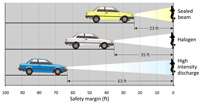 A study examining the stopping distances under different headlamp illumination conditions suggests that HID headlamps have a greater “safety margin,” or mean stopping distance, than halogen headlamps. A study examining the stopping distances under different headlamp illumination conditions suggests that HID headlamps have a greater “safety margin,” or mean stopping distance, than halogen headlamps.
In the study, funded by the Transportation Lighting Alliance (TLA: Automotive Lighting, General Electric, General Motors, Hella, OSRAM Sylvania, Philips Lighting, and Visteon), the researchers conducted a field experiment using different types of headlamp illumination (e.g., halogen and high-intensity discharge [HID]) for the detection and recognition of roadside pedestrian targets. They measured the relative ability of drivers to stop in time when detecting pedestrians about to enter the roadway, as opposed to pedestrians about to exit the roadway. The researchers then compared the results to a mathematical response time model that uses estimates of visual performance under controlled conditions not necessarily representative of those experienced while driving in the real-world.
“We found that the HID headlamps allowed drivers to see pedestrians in or near the road much earlier, allowing them to come to a stop sooner — as much as 30 feet sooner — than they did with the halogen headlamps,” said John Bullough, PhD, principal investigator and head of the LRC’s Transportation Lighting Program. The increased safety margin with HID headlamps corresponded very closely to predictions made with the LRC-developed mathematical model.
While the bluish HID headlamps are often seen as “annoying” by oncoming drivers, much of the reason may be that they are often misaligned, according to Bullough. In fact, in a recent study conducted for the National Highway Traffic Safety Administration, he found that two-thirds of a sample of more than 200 passenger vehicles had at least one misaligned headlamp, which could cause light to shine in an oncoming driver’s eyes.
|
About the Lighting Research Center
The Lighting Research Center (LRC) is part of Rensselaer Polytechnic Institute of Troy, N.Y., and is the leading university-based research center devoted to lighting. The LRC offers the world's premier graduate education in lighting, including one- and two-year master's programs and a Ph.D. program. Since 1988 the LRC has built an international reputation as a reliable source for objective information about lighting technologies, applications, and products. The LRC also provides training programs for government agencies, utilities, contractors, lighting designers, and other lighting professionals. Visit http://www.lrc.rpi.edu. |



